SEPTEMBER KEY FIGURES
 |  | Sep '05 | Aug '05 to Sep '05 | Sep '04 to Sep '05 |  |
 |  | '000 | % change | % change |  |
|  |
| Short-term visitor arrivals |  |  |  |  |
 | Trend | 460.3 | 0.4 | 4.7 |  |
 | Seasonally adjusted | 460.1 | -1.6 | . . |  |
 | Original | 414.4 | . . | . . |  |
| Short-term resident departures |  |  |  |  |
 | Trend | 406.6 | 0.5 | 10.4 |  |
 | Seasonally adjusted | 411.4 | 2.6 | . . |  |
 | Original | 486.6 | . . | . . |  |
|  |
| . . not applicable |
Visitor arrivals, Short-term

| Resident departures, Short-term

|
SEPTEMBER KEY POINTS
TREND ESTIMATES
- The trend estimate for short-term visitor arrivals to Australia during September 2005 (460,300 movements) increased by 0.4% compared with August 2005. This followed monthly increases of 0.3% for July 2005 and 0.4% for August 2005.
- Currently, short-term visitor arrivals are 0.2% lower than when the series last peaked in February 2005 (461,300 movements) and 4.7% higher than in September 2004.
- During September 2005, short-term resident departures (406,600 movements) increased by 0.5% when compared with August 2005. This followed monthly increases of 0.9% for July 2005 and 0.7% for August 2005.
- Currently, short-term resident departures are 41.6% higher than when the series last troughed in March 2003 (287,100 movements) and 10.4% higher than in September 2004.
SEASONALLY ADJUSTED ESTIMATES
- The seasonally adjusted estimate for short-term visitor arrivals during September 2005 (460,100 movements) decreased by 1.6% compared with August 2005. This followed monthly increases of 1.2% for July 2005 and 2.1% for August 2005.
- Short-term resident departures for September 2005 (411,400 movements) increased by 2.6% compared with August 2005 and followed a monthly decrease of 4.0% for July 2005 and a monthly increase of 1.2% for August 2005.
ORIGINAL ESTIMATES
- In original movement terms, there were 414,400 short-term visitor arrivals to Australia and 486,600 short-term resident departures from Australia during September 2005.
NOTES
EARLY ESTIMATES
Early estimates of short-term visitor arrivals for October 2005 will be available on the Australian Bureau of Statistics (ABS) web site on 17 November 2005. These estimates can be accessed by going to the AusStats web page <https://www.abs.gov.au/ausstats> and selecting Publications & Data and then Main Features. Select 34 Migration and then select Short-term Visitor Arrival Estimates, Australia (cat. no. 3401.0.55.001).
DATA NOTES
This publication contains movement data. Care should be taken when interpreting this movement data as 'people'. See paragraph 5 of the Explanatory Notes for more detail.
Calculations of percentage and numeric change are based on unrounded data. See paragraph 12 of the Explanatory Notes for more detail.
CHANGES IN THIS ISSUE
There are no changes in this issue.
INQUIRIES
For further information about these and related statistics, contact the National Information and Referral Service on 1300 135 070 or Anne Ward on Canberra (02) 6252 6871.
MAIN FEATURES
SHORT-TERM VISITOR ARRIVALS
In trend terms, short-term visitor arrivals to Australia in September 2005 (460,300 movements) increased 4.7% compared with September 2004. Currently, short-term visitor arrivals are 0.2% lower than when the series last peaked in February 2005 (461,300 movements). Prior to that month, short-term visitor arrivals had increased each month from February 2004 (424,900 movements).
The following table presents the top ten source countries (based on original estimates) for short-term visitor arrivals during September 2005. Seasonally adjusted and trend estimates are also presented for these countries, along with the trend percentage change compared with August 2005 and September 2004.
Short-term Visitor Arrivals, Major Source Countries - September 2005 |
|  |
 | Trend | Seasonally Adjusted | Original | Aug 05 to Sep 05 | Sep 04 to Sep 05 |  |
 | '000 | '000 | '000 | Trend % change | Trend % change |  |
|  |
| New Zealand | 90.5 | 90.9 | 110.5 | -0.6 | 3.2 |  |
| Japan | 58.1 | 63.1 | 57.1 | 3.7 | -4.6 |  |
| United Kingdom | 57.8 | 56.8 | 41.3 | -0.5 | 3.5 |  |
| United States of America | 38.1 | 37.4 | 27.2 | -0.1 | 5.6 |  |
| Singapore | 23.1 | 22.8 | 17.8 | -0.3 | 9.6 |  |
| China | 22.8 | 23.0 | 17.2 | 2.5 | 3.3 |  |
| Korea | 20.8 | 21.0 | 15.0 | -1.3 | 14.1 |  |
| Germany | 12.8 | 12.3 | 11.9 | 0.9 | 9.0 |  |
| Malaysia | 13.0 | 9.9 | 11.9 | -3.7 | -15.6 |  |
| Hong Kong | 14.0 | 13.3 | 10.7 | 0.3 | 20.2 |  |
|  |
SHORT-TERM RESIDENT DEPARTURES
In trend terms, short-term resident departures from Australia in September 2005 (406,600 movements) increased 10.4% compared with September 2004 and are 41.6% higher than when the series last troughed in March 2003 (287,100 movements).
The following table presents the top ten destinations (based on original estimates), for short-term resident departures during September 2005. Seasonally adjusted and trend estimates are also presented for these countries, along with the trend percentage change compared with August 2005 and September 2004.
Short-term Resident Departures, Major Destinations - September 2005 |
|  |
 | Trend | Seasonally Adjusted | Original | Aug 05 to Sep 05 | Sep 04 to Sep 05 |  |
 | '000 | '000 | '000 | Trend % change | Trend % change |  |
|  |
| New Zealand | 70.7 | 73.2 | 79.4 | 0.7 | 1.4 |  |
| United States of America | 36.4 | 37.0 | 45.8 | 0.8 | 16.3 |  |
| United Kingdom | 35.1 | 34.4 | 43.9 | 0.2 | 13.2 |  |
| Indonesia | 27.7 | 27.6 | 38.1 | -1.5 | 5.7 |  |
| China | 20.8 | 20.6 | 28.1 | 0.7 | 27.5 |  |
| Fiji | 16.4 | 16.7 | 20.5 | 0.3 | 8.5 |  |
| Singapore | 16.1 | 17.7 | 17.9 | 2.7 | 17.0 |  |
| Thailand | 15.6 | 14.8 | 17.8 | -0.3 | -1.1 |  |
| Italy | 7.9 | 8.3 | 16.6 | 0.8 | 2.2 |  |
| Hong Kong | 17.1 | 16.2 | 15.6 | 0.3 | 30.5 |  |
|  |
SHORT-TERM TRAVEL - THAILAND
Short-term visitor arrivals
Trend estimates for September 2005 show the number of short-term visitor arrivals from Thailand represented 1% (6,700 movements) of all short-term visitor arrivals to Australia. Over the past ten years the trend has fluctuated. The highest point in the series was in September 1996 (8,100 movements), while the lowest point was in April 1998 (3,400 movements). From this low point the trend was upwards until February 2001 where the series, while still fluctuating, has remained at a consistent level. The September 2005 trend estimate for arrivals from Thailand was 1% higher than for August 2005 and 5% higher than for September 2004.
THAILAND, Short-term Visitor Arrivals

In original terms, visitors arriving short-term from Thailand stated holiday (37%) as the main reason for journey, followed by business (17%) and visiting friends and relatives (15%). The main reasons for visiting Australia for all short-term visitors were holiday (52%), visiting friends and relatives (20%) and business (11%). The median age of visitors from Thailand was 39 years (40 years for all visitors) while the median intended duration of stay was 9 days (10 days for all visitors).
New South Wales (45%), Victoria (20%) and Queensland (15%) were the main states/territories of intended stay for short-term visitors from Thailand. While these states were also the main destination for all short-term visitors the ranking was different; New South Wales (38%) remained the most popular destination, while Queensland (32%) was more popular than Victoria (15%).
Short-term resident departures
Trend estimates show the number of residents departing Australia, short-term, for Thailand represented 4% (15,600 movements) of all short-term resident departures in September 2005. While the series has shown fluctuations over the past ten years it has generally followed an upward trend. The low point in the ten year series was in September 1995 (6,300) while the high point was in November 2004 (16,700 movements). The September 2005 trend estimate for departures to Thailand was marginally lower than for August 2005 and 1% lower than for September 2004.
The pronounced drop between October 2002 and December 2003, in the seasonally adjusted series in the following graph, shows the impact that the Bali bombing and SARS had on short-term departures of Australian residents to Thailand.
THAILAND, Short-term Resident Departures
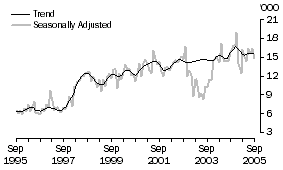
In original terms, 79% of Australian residents travelling to Thailand stated holiday as their main reason for journey, followed by business (8%) and visiting friends and relatives (7%). For all residents departing Australia short-term the main reasons for journey were holiday (53%), visiting friends and relatives (21%) and business (13%). The median age of residents departing to Thailand was 39 years (42 years for all residents) while the median intended duration of stay was 13 days for residents departing to Thailand, compared with 15 days for all residents departing short-term.
PERMANENT AND LONG-TERM MOVEMENTS
There were 11,100 permanent (settler) arrivals into Australia during September 2005, an increase of 9.4% when compared with September 2004 (10,200 movements). People born in the United Kingdom accounted for the largest proportion of settlers (20%), followed by people born in New Zealand (11%), and India and China (each 9%).
There were 4,700 Australian residents departing permanently from Australia during September 2005, an increase of 12.8% when compared with September 2004 (4,200 movements).
Statistics on overseas arrivals and departures relate to the number of movements of travellers rather than the number of travellers. Therefore, care should be taken when using long-term movements data as it is known that some individuals who travel multiple times in a year are counted each time they cross Australia's borders (see paragraph 5 of the Explanatory Notes). Long-term movements in this publication are not an appropriate source of migration statistics. For further information refer to Australian Demographic Statistics (cat. no. 3101.0).
STATISTICAL SIGNIFICANCE
The above presentation of movements in estimates does not take into account whether the change in movement is statistically significant. Care should be taken when interpreting the impact of numeric and/or percentage change. Please see the Standard Errors section of this issue for more detail.
SEASONALLY ADJUSTED AND TREND ESTIMATES
INTRODUCTION
Seasonally adjusted and trend estimates add to the understanding of overseas arrivals and departures (OAD) statistics. Seasonally adjusted estimates allow users to analyse short-term movements including irregular impacts on the series, while trend estimates provide a better method to analyse and monitor the underlying direction of the short-term movement series. In most cases, the trend series is the best source of information on the long-term direction of these statistics.
SHORT-TERM VISITOR ARRIVALS
Selected source countries
The graphs presented below illustrate the long-term increase in the trend series for arrivals from the United Kingdom and New Zealand and the significant impact of Severe Acute Respiratory Syndrome (SARS) on arrivals from Japan in mid 2003.
United Kingdom
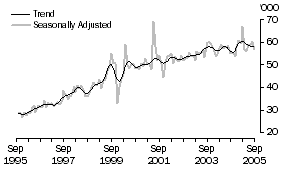
New Zealand

Japan

SHORT-TERM RESIDENT DEPARTURES
Selected destinations
For residents departing to the United States of America the graph illustrates the effect that the terrorist attacks in that country on 11 September 2001 had on short-term departures of Australian residents to the United States of America. The graph for New Zealand illustrates that departures of Australian residents, which had been experiencing strong growth since May 2003, have plateaued. For Indonesia the graph shows the impact of events such as the October 2002 Bali bombing and the reduced level of travel for the next twelve months.
United States of America
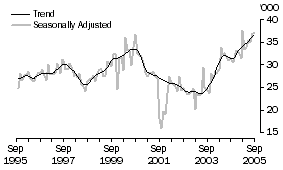
New Zealand
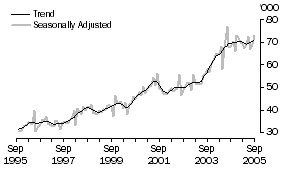
Indonesia
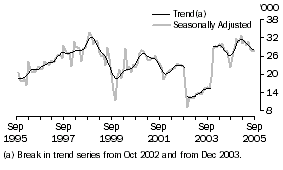
 Print Page
Print Page
 Print All
Print All